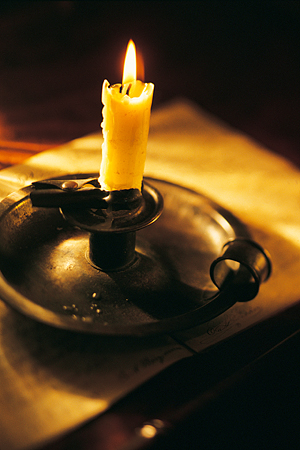
Creating a sacred space in the home
An altar can provide a focus for the experience of feeling the sacred in everyday life. It provides a dedicated space where individual family members or even the family group can go and be with God, a place to feel the reality of God's love. It can and often does become an integral part of the home life. Not that a person can't be with God where ever they happen to be, to the contrary, a feeling of the sacredness in all things is desirable. An altar is merely one way to help facilitate feelings of sacredness, reverence, and awe, by reflecting in some way common values held most dear. Establishing a sacred space in the home helps an individual feel the values of truth, beauty, goodness and love.
An altar can be a space set aside for worship and prayer, for honoring the patterns of divinity found in and around us, or for bringing God closer to us through the use of meaningful symbols. It can be all of the above and more. Children especially respond to beauty and deeply appreciate items found in nature.
The entire family can be involved in creating the altar. It is often better to allow the altar to evolve, as items are added and subtracted on a daily, weekly or special occasion basis.
How to Begin
Find or create a space in your home or yard that the family agrees upon. It can be out of the way, if the family desires a quiet area, or in a main living area, if the family desires a daily reminder of the sacred. If younger children are involved, the parents may want to create the altar initially, but as children get older they will greatly enjoy adding their own ideas and symbols to it.
Creating a Space
The space should include a platform upon which family members can arrange their meaningful items. Beauty is an essential part in the creation of a sacred space. We naturally seek and love beauty because it stimulates our minds to attain higher spiritual levels of thought. Using items from nature such as a small tree, plant, rock or shell can help create a beautiful effect. Fabric stores carry many exquisite materials, which can be used to adorn the altar and accentuate the items placed there. A fluid altar is always nice because the family can decide to change it from time to time. This allows each member of the family an opportunity at implementing their ideas.
Elements Which Can Be Added to the Altar
- Candles (Obviously only to remain lit while an adult is present!)
- Mandalas - There are excellent mandala coloring books, which can colored in by family members or beautiful mandala art can be purchased as well.
- Items from nature - Rocks, Shells, Leaves, Plants, Twigs, Nests, Blossoms, Driftwood
- Music - CD's or tapes offering a variety of music to appeal to different tastes and instruments to be played, such as a flute, chimes, ocarina, drum, or harmonica.
- Symbols - Symbols honoring different religious paths; a statue of Christ, angels or the Buddha, some Tibetan meditation bells or a Native American God's eye.
- Meaningful Sayings - Powerful bits of wisdom from any of The World's Great Religious Texts, can add contemplative thought and meaning.
- Religious Books - A religious book such as the Bible, the Koran, Upanishads, Torah or (for me) The Urantia Book, can be an essential piece.
- A Favorite Prayer - A favorite prayer is always a beautiful addition.
- Family Pictures - Members of the family and friends to be remembered in prayer.
Altar Activities
Family members can have their own quiet moments at the altar, or a family can gather around the altar at special times, like before or after a family meeting. The altar can provide a place for prayers, quiet meditation, songs, and readings of beautiful or meaningful material, as well powerful moments of grief or joy.
History of the Altar
The Urantia Book presents some interesting historical facts about altars. It could be a valuable for family members to discuss the evolution of the altar.
Here are just a few tidbits from The Urantia Book on altars:
Altar fires and lighted candles were considered the best means of resisting ghosts and evil spirits ~ The Urantia Book, 83:4.6The hearth or fireplace became a sacred spot. Stone altars were thought to be dwelling places of God. ~ The Urantia Book, 88:2.1
Today Hindus kindle altar fires with primitive fire drills because of the belief the way it has always been done is the more sacred… ~ The Urantia Book, 92:2.2
In India it was believed … that the mother was the priestess and the father the priest and the family hearth was the altar. ~ The Urantia Book, 94:1.1
Jesus' earth family had an altar in their home. It was at this altar where they would gather to sing songs of praise and say formal prayers. ~ The Urantia Book, 126:3.4
The Urantia Book says that Jesus wrote out The Lord's Prayer on a "...piece of smooth cedar board about eighteen inches square, with a piece of charcoal...." and it could be assumed that this became a part of his family's altar.)
An altar can be built temporarily on a mountaintop, on the beach, in the desert, or by a lake. A space can be created in a moment to honor the sacred moments in human experience anywhere, anytime. It is a simple and effective way to create a sense of the sacred in our everyday lives.
Peace,
Sara


